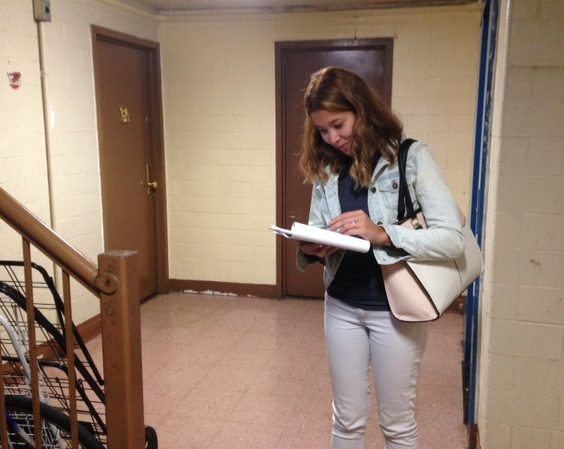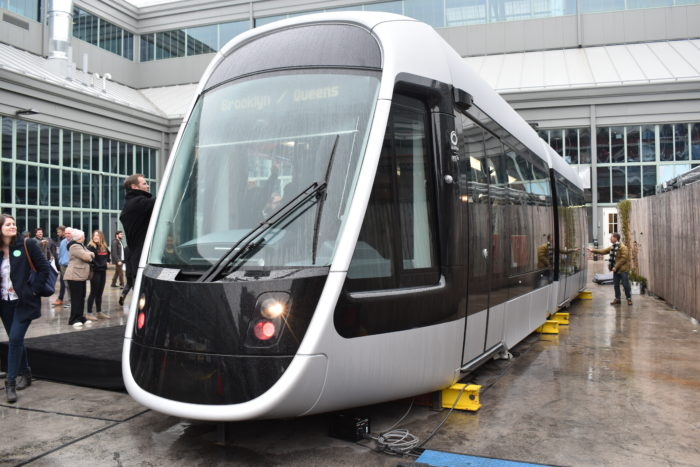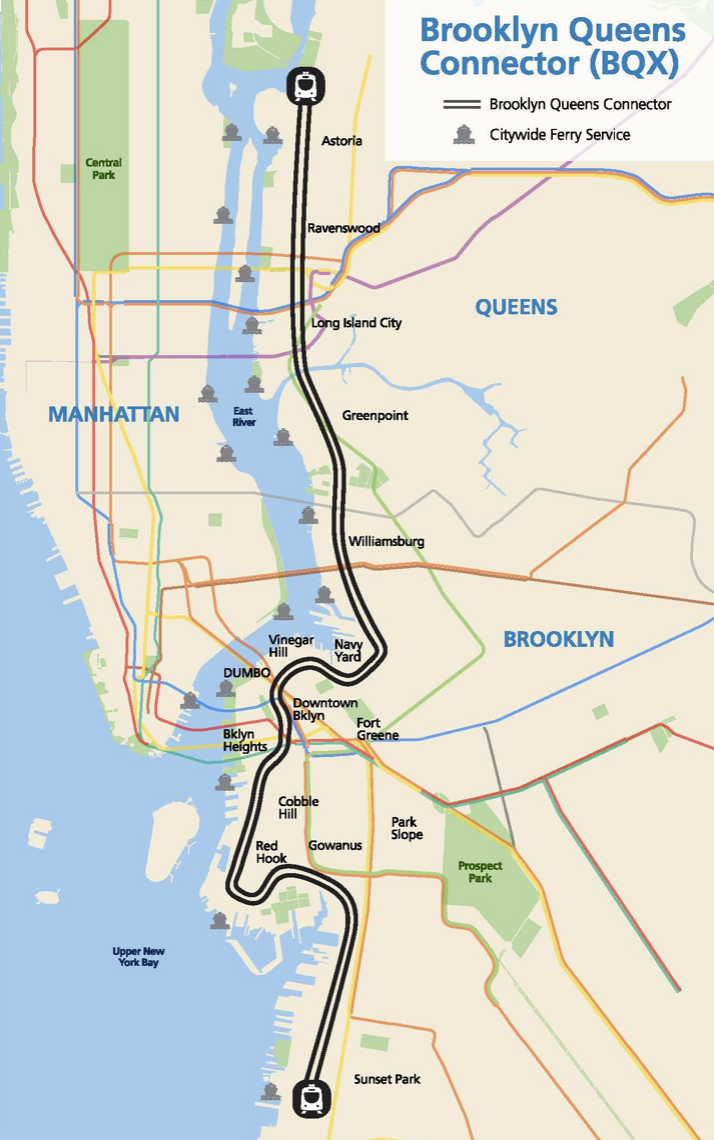On a cold evening in late October, as most New Yorkers were returning home from work, Kristina Gonzalez began knocking on doors inside the Red Hook Houses. This collection of 28 brick buildings is one of the largest public housing complexes in New York City, and also one of the most isolated. To get to the nearest subway, residents have to walk more than a half mile and cross underneath the Gowanus Expressway, which cut off the neighborhood from the rest of Brooklyn when it opened in the 1940s. In ensuing decades, residents have made due with cars, waiting for unpredictable bus service, or hiking to Carroll Gardens for the F or G train.
And that’s what Gonzalez wanted to talk about with residents of Red Hook Houses. She was canvassing for the Brooklyn-Queens Connector, a proposal introduced last year to build a 16-mile streetcar system, known as the BQX, stretching from Astoria to Sunset Park with likely stops in Long Island City, Greenpoint, Williamsburg, the Brooklyn Navy Yard, Dumbo, Downtown Brooklyn, Cobble Hill and Red Hook.
There has been no shortage of opinions on the proposal, endorsed early on by Mayor de Blasio. Questions of cost loom large. Early intentions to fund the $2.5 billion project through increased property-tax revenue, brought in by higher real-estate values and new development along the route, raised concerns that the project will not only be fueled by gentrification but will also accelerate it. Finding enough suitable above-ground space to install the route also remains a question, especially considering the recent assertion that slices of land along the route are controlled by the state. Other critics, including urban planners, argue that express buses would make more sense than a streetcar.
Amid the uncertainty, Friends of the BQX, an advocacy group backed by the real-estate firm Two Trees Management and nearly two dozen other donors, as well as endorsed by more than 100 business and community groups in Brooklyn and Queens, has made a determined effort to build public support for the project. Earlier this month, the group unveiled the first life-size prototype of the streetcar, a two-car mockup displayed in the Navy Yard.
On another front not previously disclosed, Friends of the BQX has been seeking to engage with the estimated 40,000 citizens who live in New York City Housing Authority buildings along the proposed route. For the past several months, the group has sent canvassers knocking on thousands of doors in public housing, both to advocate for the streetcar and gauge support. So far, the group has received more than 3,500 signatures in support of the project, and they plan to continue local outreach in advance of a public-review process that could begin as early as 2018.

Kristina Gonzalez, a canvasser for the BQX, made the rounds of the Red Hook Houses in October (Photo by Emily Nonko)
In the Red Hook Houses on that October evening, many residents were more than willing to talk about transportation with Gonzalez, a warm, 24-year-old Fort Greene native with a background in political canvassing. She led a team of canvassers here a few months earlier, to collect signatures for a letter of endorsement that was later delivered to residents.
Several residents Gonzalez spoke with in October, as a reporter accompanied her, were familiar with the BQX proposal because of the prior canvassing. That included Jimmie Bradley, 57, who has lived in Red Hook West since 1973 and worked as a school-bus inspector before he retired. “My impression is that this would be good for everyone,” he said. “In a way, we’re isolated from the rest of the borough. There’s only one way in and one way out.”
Bradley didn’t view the streetcar as a harbinger of gentrification; rather, he saw it as a way for public-housing residents to benefit from the new amenities that gentrification often brings in. “Why not us?” he asked of better transit options. “Don’t leave us out in the cold.”
Bradley owns a van, but noted that many residents in the area cannot afford a car. Indeed, it was a concern Gonzalez heard often as she advocated for the BQX in Red Hook. One woman detailed her work day, which involved leaving her home at 4:30 a.m., only to wait up to 45 minutes for the bus to arrive. Another woman simply stated she had “nothing nice to say” about the current subway and bus service offered in the neighborhood.
Gonzalez prompted conversation about above-ground boarding as an alternative to inaccessible subway stations. (Red Hook’s closest subway, at Smith-9th Streets, offers no elevator access to wheelchair users.) An elderly man using a walker told Gonzalez he is unable to take the train “on bad days.” Parents, too, expressed a need for public transit that better accommodated strollers.

Early this month, advocates of the streetcar unveiled a French-made prototype in the Brooklyn Navy Yard (Photo by Steve Koepp)
The urgent need for better transit dominated the conversations. Though some wondered what a ride on the BQX would cost–advocates say the fare will be the same as standard bus and subway fares–no one on the Red Hook visit pressed Gonzalez for details on the route or funding. Even so, an early challenge, canvassers have found, is just helping New Yorkers visualize what trolley service would even look like, since the last one in Brooklyn shut down in 1956. “A lot of the more senior residents who remember a time when streetcars ran in New York City were not as skeptical,” said Ya-Ting Liu, executive director of Friends of the BQX. “For everybody else, it’s about the visual and asking people to imagine an above-ground rail. We’re showing them a modern, urban, light rail that’s much more prevalent in European cities.”
While gentrification concerns did not come up during the Red Hook canvassing, some community groups believe the streetcar will further gentrify areas like Sunset Park, which are quickly losing affordable housing. The waterfront, in particular, has become a point of contention. Underdeveloped waterfront areas not well connected to public transit were once chosen for public-housing development; now these neighborhoods are exploding in property value due to the East River views and new jobs in areas like the Brooklyn Tech Triangle.
Friends of the BQX pushes back on the idea that the streetcar would primarily serve gentrifiers. “I think there’s some misunderstanding in the diverse communities along the waterfront. Growth has been concentrated around places with good existing subway access,” said Liu. “The fact of the matter is that there are communities cut off, and left behind, from that growth and community.” Liu said the route is also designed to connect more New Yorkers to job growth in places like the Navy Yard and Industry City.
A few days after her time in Red Hook, Gonzalez was back canvassing, this time inside the Ingersoll Houses in Fort Greene. The tone of the canvassing was different, as residents have better access to public transit than their Red Hook counterparts. Still, frustrations ran high with the MTA.
“We need another option, just to lighten the load,” said Tara Bryan, a resident with young children. Others expressed a need for better access to Queens, either for work or visiting family and friends. Anthony Sosa, a tenant representative for the Ingersoll Houses, said in a telephone interview that “the connection to Queens is one of the most important issues to residents.” Isabella Lee, a tenant representative for the nearby Whitman Houses, echoed the sentiment. Initially, she had concerns about the streetcar taking away much-needed parking. “But I spoke to a lot of my residents … a lot of them work in Queens and it would be good for them.”
One resident of the Ingersoll Houses did react negatively to Gonzalez’s outreach. While expressing disdain and shutting the door, she said, “They’re trying to take over everything.”
Some critics have said the BQX proposal is an overreach by its benefactors, who have significant stakes in the area’s real estate and economy. Other skeptics, still waiting on a feasibility report to be delivered by the city, have dismissed it as a pipe dream. But residents of public housing–like many New Yorkers–are simply desperate for alternatives to the city’s failing subway. “Something’s gotta give,” as Sosa put it. “We cannot be held hostage by transit.”

The route study area spans from Sunset Park to Astoria, Queens (Map by the New York City Economic Development Corp.)
This report is being co-published by The Bridge and the Brooklyn Daily Eagle